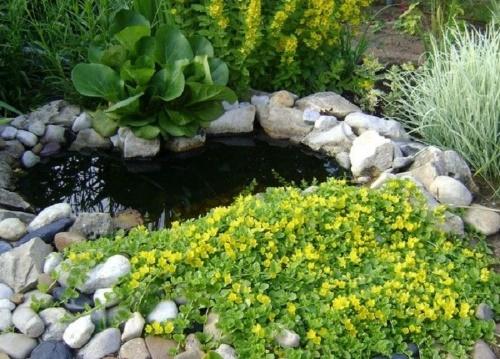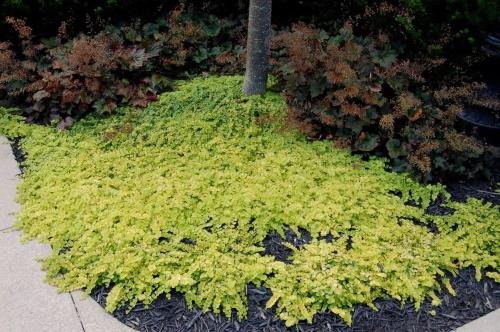Monet loam is an unpretentious ground cover for any garden
 Among the ground cover plants, it is worth noting the coin loosestrife. He not only looks gorgeous anywhere, but also has an unpretentious character. It is one of the most undemanding crops that can grow in both sun and shade. In addition, the loosestrife is distinguished by its rapid growth and high frost resistance. Agree that this is important for our winter. In addition, the bushes also bloom brightly with a scattering of sunny yellow inflorescences. Having planted them once in the garden, you will admire almost a loosestrife lawn for many years. However, so that it does not turn into a weed due to a well-developed, sprawling root system, you should still pay a little attention to the plant.
Among the ground cover plants, it is worth noting the coin loosestrife. He not only looks gorgeous anywhere, but also has an unpretentious character. It is one of the most undemanding crops that can grow in both sun and shade. In addition, the loosestrife is distinguished by its rapid growth and high frost resistance. Agree that this is important for our winter. In addition, the bushes also bloom brightly with a scattering of sunny yellow inflorescences. Having planted them once in the garden, you will admire almost a loosestrife lawn for many years. However, so that it does not turn into a weed due to a well-developed, sprawling root system, you should still pay a little attention to the plant.
For the roots quickly spreading over the site, the loosestrife is called the snake root or creeper. For its round leaves, it is called a penny grass, and for the medicinal properties of the leaves - meadow tea. The scientific name of the culture is lysimachia nummularia.
What does a plant look like

The twigs are densely covered with small rounded leaves, shaped like coins. The delicate light green color of the leaves harmonizes wonderfully with the yellow flowers blooming in the central part of the shoots. Meadow tea blooms from May to August. In shaded areas, the flowering time is shifted by a month.
The loosestrife belongs to the primroses family, and its closest relatives are cyclamen, primrose, ambilanthus.
Loose leaf in the garden - features of cultivation
 There will be no problems with choosing a place for a plant, it feels great both in the sun and in a shady corner. The loosestrife is not picky about the soil either, unless it will definitely take root in sand and clay.
There will be no problems with choosing a place for a plant, it feels great both in the sun and in a shady corner. The loosestrife is not picky about the soil either, unless it will definitely take root in sand and clay.
The care of the ground cover is the most minimal:
- In sunny areas, watering is required, in the shade or near a reservoir - only in dry summers.
- Fertilizers are needed only on completely poor soil, and even then, quite peaty mulch... If you need the bush to grow quickly, you can feed it with humus several times.
- In the fall, you should cut out the dried shoots and significantly shorten the remaining branches, leaving only their lower part.
Given the aggressive nature, when planting, it is advisable to protect the place for meadow tea by digging in the slate. Otherwise, you will have to regularly and mercilessly shorten and cut down part of the plant. If this is not done, it will spread throughout the entire site.
Loose grass hibernates without shelter, its roots are protected by the earth itself. The culture is propagated by seeds, but most often - by buried layers or cuttings.Bushes grown from seeds bloom only in the third year of life, moreover, the seeds do not differ in high germination.